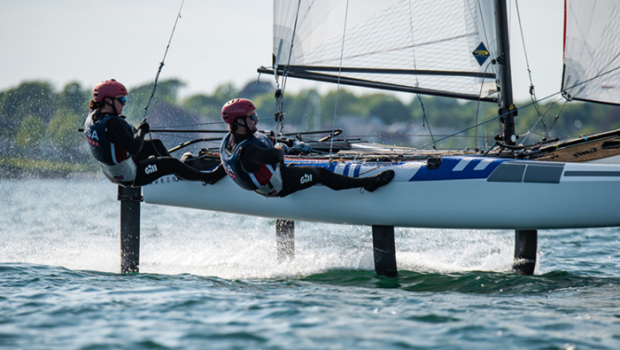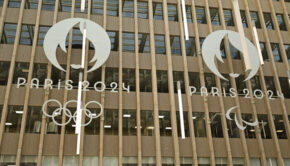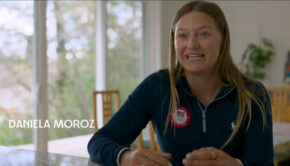Climbing learning curve to Paris 2024
Published on October 10th, 2022
The Nacra 17 was created for the Mixed Multihull event at the Rio 2016 Olympics, and while it was intended to reflect modern catamaran design, it has required significant upgrades to keep pace. First it was the addition of foiling boards, but the boat proved unstable, so the latest is an updated rudder system.
By all accounts, the boat is going well but each change requires teams to start over, and some solve the puzzle quicker than others. In this report, the top ranked USA team of Sarah Newberry and David Liebenberg share their progress:
This year has been quite the learning curve for the whole Nacra 17 fleet, and the intense improvement that the fleet is undergoing has been very interesting to be part of.
Since we sailed our first international event in April in Hyeres (France), we have had the repeated experience of training hard, getting faster at upwind foiling, feeling confident with our improvements, and then traveling to our next competition only to find out the whole fleet has also improved their upwind speed!
Racing this boat is an awesome challenge to be able to take on.
We are working hard to accelerate our learning curve in the new dynamic that upwind foiling has brought to the Nacra fleet. At several points throughout the year we identified what skills we needed to work on, and have been 17 focused on methodically improving them during each training period between events.
Before the 2022 Worlds this summer in Halifax (Canada), we had improved many things, but there were not enough days or hours to master all of our target skills before racing started. This is always the challenge in our sport – time is precious!
While we are pleased to finish 16th in the World with less than a year back in the boat (and to qualify for the US Sailing Team), we certainly learned what skills to add to the list of work-ons.
Downwind speed was one of these elusive skills, and it was a real drag at the worlds (pun intended) to be slow on the downwind legs. We lost an average of two boats per run, which added up to 30+ points throughout the event. That’s a big number, and the difference between a top 15 and a top 10 finish in our fleet.
We were never quite putting all of our puzzle pieces together consistently, but we had moments of real brilliance. One race we would have a great start and fall backward into the mid fleet after a bad decision, and the next race we would have a bad start, foul someone on the first beat, take our penalty turns, and rip forward to the top 12!
In the middle of the regatta we were finally able to string a few stellar races together and had a 1, 2 on the third day of racing, showing us just what it looks when the puzzle pieces come together.
We became one of the only teams in the world to take a win off of the gold medal winning Italian team of Ruggero Tita/Caterina Banti. That gave us a lot of encouragement and it is a beacon of what can be achieved with time, patience, and the commitment to doing the hard and sometimes tedious work to improve.
Now it’s time to continue the hard work to attain the consistency that will allow us to reach the level we know we can, and we have wasted no time getting started. After a short break post-Worlds, we left the USA in mid-September for the 2024 Olympic venue in Marseille (France) for three weeks of training with some of the best teams in the world.
For the first week, we had great breeze and waves and were finally able to diagnose the biggest problems with our downwind speed. Big step forward! We are now pacing with fast teams downwind in training. Now it will require countless hours of repetition to be able to implement this new speed on the race course. Good thing we have a few months to get in the reps before our next competition in March 2023.
Currently we are still in Marseille, halfway through this October training camp. This week we are working on upwind foiling in chop and waves. Super cool to learn how the rig setup affects the ease of sailing/trim in the sea state and how body weight can be best used to attain stability on the foil upwind. We are chipping away at better upwind speed in breeze and waves and it’s really exciting.
We will take a week off at the end of the October and then put in more time on the water here at the Olympic venue in November. After that, Thanksgiving with family, and then some weeks of training at home with the US Team in Miami in December.
More information: https://usa50racing.com/
Paris 2024 Olympic Sailing Program:
Men’s One Person Dinghy – ILCA 7
Women’s One Person Dinghy – ILCA 6
Mixed Two Person Dinghy – 470
Men’s Skiff – 49er
Women’s Skiff – 49erFx
Men’s Kiteboard – Formula Kite Class
Women’s Kiteboard – Formula Kite Class
Men’s Windsurfing – iQFoil
Women’s Windsurfing – iQFoil
Mixed Multihull – Nacra 17
Venue: Marseille, France
Dates: July 26-August 11
Details: https://www.paris2024.org/en/the-olympic-games-paris-2024/









 We’ll keep your information safe.
We’ll keep your information safe.